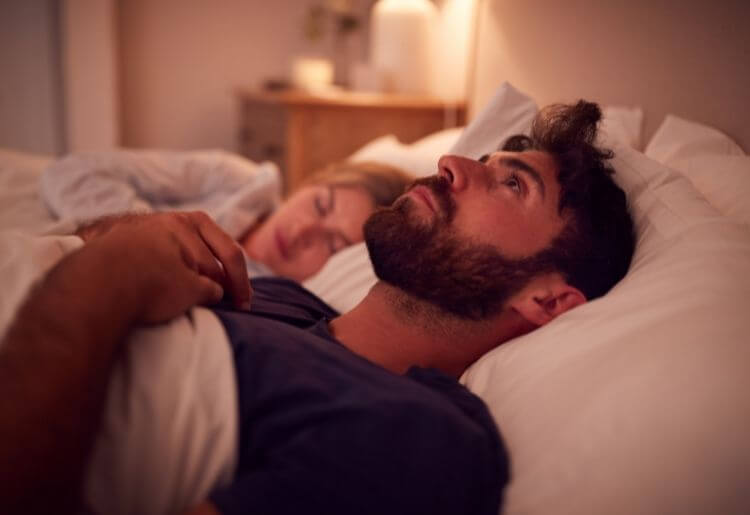It happens to all of us at one time or another. But when it becomes chronic, insomnia increases the risks for other health problems like high blood pressure, heart disease, chronic pain, and diabetes.
There are several drug-free techniques that can be helpful in improving overall sleep patterns. Many of these are drawn from cognitive behavioral therapy for insomnia, also called CBTI. Stanford Health Care has an in-depth guide to CBTI that explains how the process works to change people’s image of the bed from a place of wakeful worry to one of rest and relaxation.
You can learn more about CBTI and related techniques by working directly with a therapist, either online or in person. If you are interested in working with a telehealth counselor, check out our list of the best online therapy services to find someone who specializes in sleep issues.
In the meantime, here’s our list of the top 10 therapy techniques for improved sleep. They take practice, but over time they may help you capture those elusive ZZZs.
1. Notice negative self-talk
Often the first step in improving sleep patterns is recognizing destructive negative beliefs that may be contributing to your sleeplessness. There are many types of negative thoughts that interfere with sleep. Here are some common ones:
- “I’m not going to sleep a wink tonight.”
- “Why am I so terrible at falling asleep?”
- “I won’t be able to function at work tomorrow if I don’t fall asleep soon.”
Taking note of habitual negative thought patterns is a big step in making positive changes. It’s not always easy to recognize these thoughts on our own. If your negative self-talk is a deeply set habit, you may benefit from professional help.
2. Replace negative thoughts with positive ones
This is easier said than done, but once you have identified negative thoughts, you can try switching to positive self-talk. It may feel silly at first, but coming up with positive, relaxed statements to replace the negative ones can be important in helping you relax. Here are some ideas for replacements of the negative thoughts in #1:
- “I don’t know if or when I’ll sleep, but it’s nice to relax here in bed.”
- “I am not alone: millions of other people have trouble falling asleep.”
- “I will get through the day tomorrow, whenever I fall asleep today. I can still relax here, even if I can’t sleep.”
Working with a counselor can help you replace your negative thoughts with positive ones. If you are considering working with an online therapist who specializes in CBT techniques, consider Online-therapy.com, which emphasizes independent CBT work in tandem with therapy sessions.
3. Improve nighttime sleep hygiene
You can’t expect yourself to switch from a busy, stimulating day and evening directly into a restful night of sleep. Staring at TVs and other electronic devices is counter-productive in allowing the brain to relax. Experiment with healthy methods to unwind. Some examples include reading a book, gentle stretching, and listening to music or soothing audio tracks. When you find what works for you, you can start a new habit to incorporate that technique into your nightly routine.
While many people turn to alcohol to unwind, the rebound effects are real: while you may conk off earlier with a nightcap, you're more likely to wake up in the middle of the night as your body processes the alcohol.
4. Improve daytime sleep hygiene
What you do during daylight hours can have a big impact later when you’re trying to sleep. Be sure to get enough exercise during the day, as it is proven to reduce stress and anxiety. Caffeine can stay in your bloodstream for many hours, so try to stop drinking coffee and other caffeinated beverages at least 8 hours before bed.
Limit sugar and other stimulants later in the day as well and avoid eating large meals before bed. Learning positive ways to cope with stress during the day can also help you avoid bringing anxious thoughts to bed with you. Read here for tips on how to efficiently handle stress.
5. Take stock of your sleep environment
You may already know that your bedroom should be dark, quiet, cool, and comfortable. Consider altering your surroundings if they are not conducive to sleep. This may mean adding blackout shades to your windows, using a sleep mask and earplugs, or trying a white noise machine.

6. Try stimulus control therapy
A stimulus is something that causes a response. For many people with insomnia, the bed is a stimulus that causes panic, frustration, or anxiety because of past sleepless nights. The stimulus control method works to change the bed from a negative stimulus to a positive one. It helps you train yourself to sleep when you’re in bed by restricting the use of the bed only for sleep and sex.
In addition, it requires leaving the bedroom if you can’t fall asleep within 20 minutes. After some time away from the bedroom, you can return again when you feel sleepy.
Eventually, this technique transforms the bed from an anxiety-provoking stimulus to a sleep-inducing one. The American Academy of Sleep Medicine provides more information about stimulus control and other therapeutic methods for improving sleep.
7. Restrict your sleep
It sounds counterintuitive, but if you practice the sleep restriction method, you may be able to bring about long term improvements. You can start by restricting the number of hours you spend in bed at night and resisting the urge to nap throughout the day.
The number of hours is based on the usual amount of time you spend sleeping per night. So, if you normally spend eight hours in bed, but only sleep for five, you’d begin by only allowing yourself only five hours in bed.
Sleep restriction helps reduce the amount of time you spend being sleepless in bed, so it helps train your brain to be sleepy—not anxious and wakeful—when you are in bed. Since it reduces your overall time for potential sleep, you may be more fatigued than usual in the early days of the process.
Gradually, you’ll be able to increase the time spent in bed each night and improve your levels of sleepiness associated with the bed.
8. Work on relaxation techniques
There are several approaches to train your brain to relax. Here are some helpful ones:
- Breathe work - Breathe deeply and fully, in through the nose and out through the mouth. Counting each breath can still help your mind and lower your levels of stress.
- Meditation - This can be an intimidating word for people who haven’t had much practice. There are several free apps that make meditation simple and easy to try. The basis of most meditation techniques involves focusing on the breath, recognizing thoughts that drift in, then letting them drift away.
- Muscle relaxation - Mentally work your way through all parts of the body, starting at the feet. Focus on one area at a time, tensing and relaxing as you go. At the end of the progression, your entire body should feel more relaxed.
9. Try paradoxical intention
This is like reverse psychology for sleep. We all know that worrying about falling asleep can be one of the biggest things keeping us awake. If you intentionally resist the effort to fall asleep, you let go of that worry and are better able to relax and fall asleep.
10. Listen to your body
Biofeedback is a popular technique that allows you to pay attention to your body’s signals—like heart rate, breathing, body temperature, blood pressure and brain waves—and make conscious efforts to improve them. This method involves wearing a device with sensors to provide information on your signals to help you make improvements.
You may need to experiment with a mix of methods to settle your brain and relax your body to sleep. Working directly with a therapist who specializes in sleep issues is a great option for drug-free improvements and better rest. An experienced counselor will work with you on all aspects of healthy sleep, from CBT to sleep hygiene and relaxation techniques.
Our list of the best online therapists can be a great place to start. With time and practice, you’ll be well on your way to a better night’s rest.
